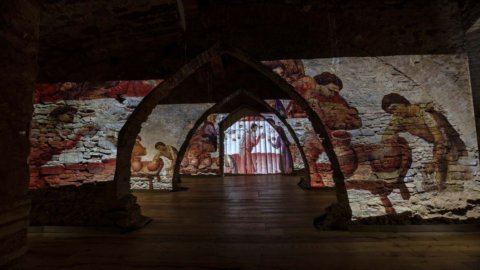Making Montalcino known in an articulated and profound way through a complete experience that from Brunello, its Gold, opens up towards the millenary history, archeology, artistic heritage, the landscape and the promotion of the other precious products of a territory of great wealth. With this in mind, today the Temple of Brunello opens its doors in Montalcino, a demanding project promoted by the Archdiocese of Siena, Colle di Val d'Elsa and Montalcino, by the Municipality of Montalcino, by the Consorzio del Vino Brunello di Montalcino and created by Opera Laboratories with the intention of wanting to ensure a brilliant and innovative future for Montalcino and its territory.
The Temple of Brunello therefore becomes an expression of the Gold of Montalcino, a cultural operation which intends to collect, communicate, make known and experience, also with the help of the most advanced technologies, the set of potentialities expressed by one of the territories which by vocation winery and for the iconic charm of the landscape lines it is already one of the most appreciated in the world.
The experience of l'Oro di Montalcino begins in the former convent and monumental complex of Sant'Agostino, the millenary and cultural heart of the city. The former convent dates back to the thirteenth century, when the presence of the first Augustinian fathers in Montalcino is documented and develops next to the church dedicated to Saints Philip and James, known as Sant'Agostino, a treasure trove of precious frescoes of the Sienese school of the second half of the fourteenth century . The welcoming and meditative dimension of InChiostro, the first covered cloister of the former convent, represents the starting point of the various experiential itineraries: from here, thanks to the 'L'Oro di Montalcino' application, it is possible to be guided inside the church of St. Augustine.
The visit then continues inside the suggestive underground Archaeological Museum, illustrated in the first person by the archaeologists, Luca Cappuccini, Luigi Donati and Jacopo Tabolli, who discovered and studied the preserved Etruscan finds, largely coming from the nearby Poggio Civitella, the only example of an Etruscan fortress still existing today.
From Inchiostro you then enter the Civic and Diocesan Museum Collections, a rich collection of wooden statues and 'gold funds' of the Sienese school owned by the municipality and coming from the churches of the ancient diocese, all to be discovered, embellished by a substantial collection of archaic majolica from the thirteenth century and from the ancient works of the nearby Abbey of Sant'Antimo. The notes of a young flautist from Montalcino, Cecilia Cuglitore, will accompany the historical-artistic commentary on the most representative paintings.
The video interview with Professor Bruno Bonucci will trace a historical profile from medieval Montalcino to the contemporary age, highlighting the productive, artisanal and entrepreneurial vocation of the Montalcino community from its embryonic state up to the Brunello economy.
From Inchiostro then begins the experience of discovering the luxuriant territory of Montalcino: stations with virtual reality viewers called InVolo will allow you to immerse yourself in villas and castles, breathtaking views of the city center, small towns of the vast and diversified municipal area. If in the fourteenth-century frescoes with the Effects of Good Government Ambrogio Lorenzetti ventured into a new form of painting expression to glide over the Sienese countryside 'from a bird's eye view' in order to present its beauty and productivity, in Montalcino today the most modern technologies allow you to experience the wonders of the area through a new gaze that embraces the landscape from the light of dawn to that of sunset; once the journey inside the complex of Sant'Agostino is finished, the real experience of visiting the historic center and the countryside outside the castle walls, along the different slopes of the hill, is proposed and encouraged.
Passing through the open cloister, once called the 'summer cloister' of the convent, one descends into the Temple of Brunello; walking down the staircase, one perceives a change in level of depth, a gradatio of climate, from light to darkness, while the sounds of the cellar also refer to the 'gradation' of the wine: so profound is Brunello's belonging to the territory of Montalcino, the more aware and distinctive the personality of the wine.
The Temple of Brunello, whose layout was created by Opera Laboratori and for the multimedia part by ETT, a leading company respectively in the museum sector and digital innovation, is divided into the underground rooms of the former convent, adjacent to the headquarters of the Consorzio del Brunello wine. The Consortium's contribution to the project, thanks to the advice of the vice-president Stefano Cinelli Colombini and the scientific supervision of Gabriele Gorelli, the first Italian Master of Wine, played a primary and decisive role.
"With the Gold of Montalcino and the Temple of Brunello - says Giuseppe Costa, president of Opera Laboratori - we wanted to combine the experience acquired in over twenty years of museum management with the competence and sensitivity of those who have accompanied us on this path".
Next to the headquarters of the Consortium inside what was once the Rex, the old cinema of Montalcino, it is as if today the secret of Brunello, the true King of the territory, is kept. We approach it through immersive videos that evoke the four pillars, or the founding concepts that have determined the uniqueness of Montalcino wine: the soil, the biodiversity of the area, the climate, the work of the people, their belief in it and knowing it to do with respect for tradition, scrupulous and humble everyday life and a clear future perspective. These concepts will be reaffirmed by the clarity of the Voices of Brunello, an exchange of jokes between those who have brought novelty and positive energy to the world in Brunello, only real people, as representatives of an authentic community.
As the rows, verdant furrows on the ground, mark and design the territory of Montalcino, we proceed in the next space, called Quadro divino, where the visitor can leave the 'sign' of his experience along the way and put his creativity into play, developing the sensations and suggestions received in previous experiences. The divine framework is therefore the sign of the experience on the visitor, who in turn is invited to leave his mark on the place, a bit like the path he took through the area to get to Montalcino. The colours, images and atmospheres are presented here in a real color palette, the visual identity of Montalcino, to be used freely and emotionally. Each visitor will thus be able to create, through touch stations, their own artistic composition, which can be sent to the wall and shared via email and social networks.
The third underground room, supported by ogival arches, whose shapes refer to an overturned chalice, is Calix. Here, through the mapping technique accompanied by evocative sounds created specifically for the Brunello Temple, the visitor will find himself immersed in an experience with a strong emotional impact: artistic masterpieces will be presented, expression of the inspiration and creative work that the land of Montalcino has been able to instill in man. From the landscape of the Effects of Good Government we pass to the fourteenth-century tables of the miracle of the Wedding at Cana and the Last Supper where the wine is served in ceramics similar to those conserved in the Museum of Montalcino. The screening concludes with the Madonna della Misericordia by Vincenzo Tamagni which ideally protects the entire Montalcino area, evoking the deep Marian devotion of the area.
Going up, we arrive again in the light of the open cloister where it will be possible to share and conclude the experience, talking about culture, art and wine while sipping a glass of Brunello at the Enoteca Bistrot Caffetteria del Tempio del Brunello. A place of convivial dissemination where you can approach wine knowledge at all levels. Through the mobile application device, in fact, it will be possible to answer a series of questions relating to one's temperament in order to guide the visitor in choosing the Brunello most in line with one's personality. You will then be guided by professional sommeliers and a multilingual digital sommelier, who will allow you to grasp the gestures and rituals that accompany the tasting, outlining the organoleptic characteristics of the Rosso and Brunello di Montalcino.
Passing again from Inchiostro towards the exit, through the mobile application, four video interviews will illustrate the golds of Montalcino. Honey, saffron, oil and truffles will be presented by Federico Ciacci, Marzio Saladini, Carlo Alberto Bindi and Paolo Valdambrini who will talk about the properties, history and tradition of the four products, principles of the territory.
Leaving the Sant'Agostino complex, whoever wants to can continue the journey through art, history, culture and taste, to discover what makes Montalcino and its territory unique. Through the mobile application, the visitor will be guided towards the major geolocated points of interest and commented by text, audio, photo gallery and video files that will integrate the visit: from the cathedral of San Salvatore to the Palazzo Comunale di Montalcino, from the Abbey of Sant 'Antimo up to San Giovanni d'Asso, from the castle of Poggio alle Mura to San Michele lost in the woods, from the Abbadia Ardenga to Montisi, you can embrace the whole municipal area that offers itself with pride and authenticity in the heart.
“After a year and a half of the pandemic in which our energies were concentrated on supporting the community - says the mayor of Montalcino Silvio Franceschelli - we have also looked to the future and this project is new lifeblood for us. Montalcino longs for rebirth, now is the time. Working in concert with the Archdiocese and the Brunello Consortium, with the operational arm of Opera Laboratori, we intend not only to promote our territory through an innovative formula that can effectively welcome visitors, but to create within the complex of Sant 'Agostino new stimuli and cultural spaces for the Montalcino community where art, history, music, craftsmanship and products of excellence can merge with the productive culture in an organic project".
“We are convinced that the journey of wine does not end in a glass - continues the president of the Brunello di Montalcino Wine Consortium Fabrizio Bindocci - but is increasingly an important phenomenon also from a cultural point of view. This project makes us enthusiastic because the Brunello Temple is not only a modern and interactive museum, but also a profoundly representative experience of its territory that will give added value to the promotional activity that the Consortium itself already carries out for the entire socio-economic system of Montalcino".





